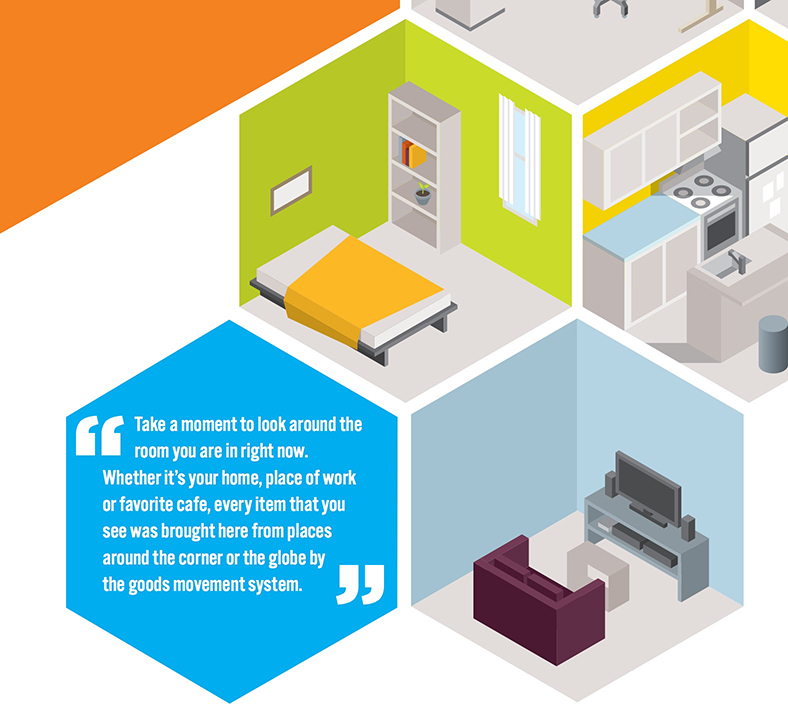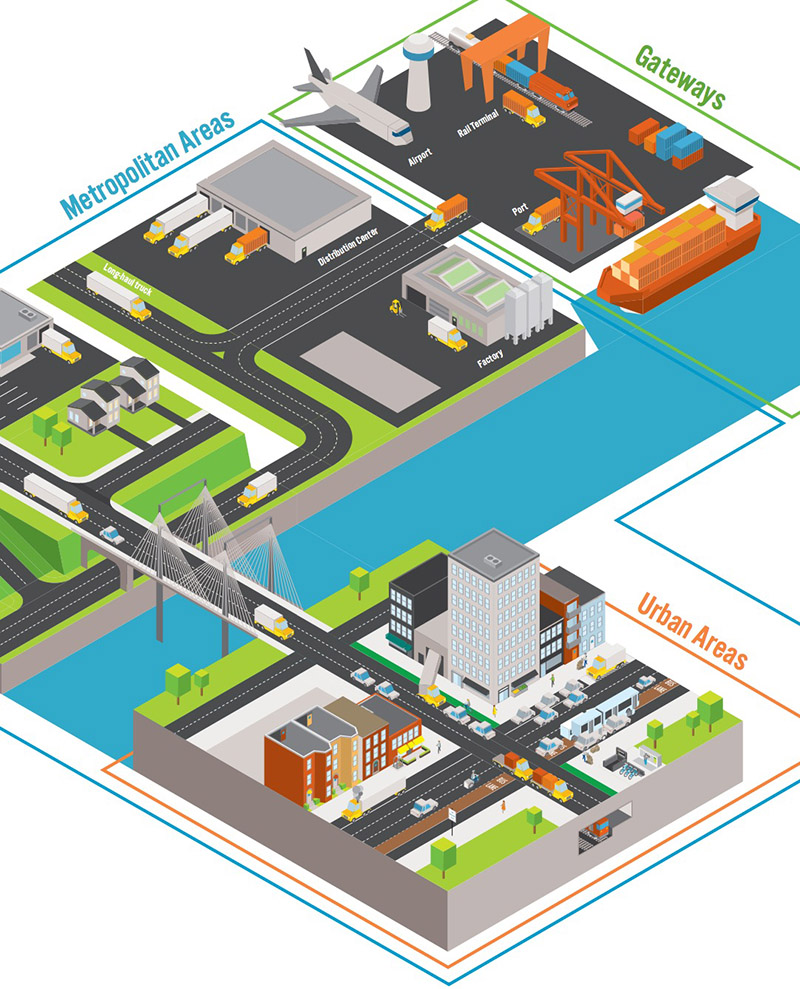REGIONAL PLAN ASSOCIATION
 Goods movement is critical to everyday life. Take a moment to look around the room you are in right now. Whether it’s your home, place of work or favorite cafe, every item that you see was brought here from places around the corner or the globe by the goods movement system. Goods are the meats and vegetables you cook for dinner, the clothes you buy in the store and order online, the pens you write with at your desk, the walls holding up the buildings around you, and the trash you generate. We live in a world built on trade where the goods movement sector connects people to these goods and goods to people on many levels, from local to global. Just as you must travel to get to your job or to visit a friend, all of the goods that you consume and support your daily life must also travel to their final destination.
Goods movement is critical to everyday life. Take a moment to look around the room you are in right now. Whether it’s your home, place of work or favorite cafe, every item that you see was brought here from places around the corner or the globe by the goods movement system. Goods are the meats and vegetables you cook for dinner, the clothes you buy in the store and order online, the pens you write with at your desk, the walls holding up the buildings around you, and the trash you generate. We live in a world built on trade where the goods movement sector connects people to these goods and goods to people on many levels, from local to global. Just as you must travel to get to your job or to visit a friend, all of the goods that you consume and support your daily life must also travel to their final destination.
The majority of industries and economic activities that consumers and producers depend upon – from grocery stores and restaurants to retail shops, office supplies and construction – rely on the distribution of goods. For example, there are 24,000 food establishments in New York City, 18,000 of which are restaurants. Many of these restaurants typically receive three to four deliveries per day for items such as fresh goods, liquor and bulk goods. As a result, this industry alone creates 72,000 to 96,000 daily trips on the streets on New York City. Not only does the industry provide the goods needed to sustain an economy, but it also is a generator of a significant number of direct and indirect jobs.
The efficient delivery of products is critical to the satisfaction of the customer, the success of individual businesses and the urban and global economies. Yet in order to reach the final destination, goods distributors face significant challenges across urban and metropolitan environments: congested city streets, regional highways and rail networks, and bottlenecked ports and airports. The distribution of goods also contributes to this congestion, increasing emissions and noise on the streets. In the U.S., trucks account of 18% of the cost of congestion although they only represent 7% of urban travel.
Impeding the movement of goods impedes the economy. In the extreme situation where the supply chain comes to a standstill in a large metropolitan area, effects will be felt by locals and ripple out across the world. If action is not taken to remedy the situation fast, residents will lose access to basic life necessities. Hospitals would exhaust their critical supplies in just 24 hours, service stations would run out of fuel in 48 hours, and grocery stores would be out of perishables in 72 hours.
Goods movement must be flexible and able to accommodate rapidly changing environments. Today there is an immense amount of pressure placed upon the goods movement industry. Online sales are growing three times faster than traditional retail sales and companies have shifted to just-in-time deliveries – receiving goods only as they are needed to reduce inventory cost – requiring more frequent and customized deliveries. Modern societal and technological trends, particularly the rise of consumerism and the service sector, impose even more demand on urban distribution systems that must operate within already dense, congested and strained networks.
For decades, goods movement has existed in an ecosystem that has typically been openly hostile to it or given it a lower priority. Until recently urban freight had been overlooked by urban planners and the government. However, even though goods distribution trips are a part of an industry and system that are invisible to most people, goods movement is absolutely critical to people’s lives and must be addressed as a key component of the livability and efficiency of our cities today.
Where Goods Go, Metropolitan Areas
In 2010, for the first time ever, 50% of the world population was living in a metropolitan area; in the United States, Canada and Europe this figure was over 80%.6 More than 80% of global GDP is generated in cities, urban areas are becoming more attractive and the number of urban residents is expected to increase by 1.5 times by 2045.7 With more people come higher demand and the need for more deliveries of goods to these areas. It is estimated that close to almost all of global trade originates, traverses through or is destined for a metropolitan area.
As a result, metropolitan areas are the main hubs in the global goods distribution network. They are home to intermodal terminals such as ports, airports and rail yards that serve as the interfaces between the global supply chain and the more local, national and urban supply chain. Goods are both produced and consumed in these places, with some metropolitan areas primarily serving as global manufacturing or trade centers while others mostly serve as consumers of finished products.
As shown in the illustration, the metropolitan goods movement system operates on two scales: 1) goods travelling into and out of a metropolitan area, and 2) goods travelling within a metropolitan area. Once goods arrive at a major gateway – a port, air or rail terminal – they are typically transported to logistics facilities within a metropolitan area – such as warehouses and distribution centers – for processing and then are routed to their final destinations. These destinations may be local (within the same metro area), or regional (to other metro areas). At the same time, metro areas are producers of goods that are exported to other cities and regions. While the entire network is interdependent and must function cohesively, particular attention must be paid to the goods transported and delivered to the growing number of consumers located in complex urban environments.
Download full version (PDF): Why Goods Movement Matters
About the Regional Plan Association
www.rpa.org
RPA is America’s most distinguished urban research and advocacy organization. RPA works to improve the prosperity, infrastructure, sustainability and quality of life of the New York-New Jersey-Connecticut metropolitan region.
Tags: Freight, Regional Plan Association, RPA, Shipping







 RSS Feed
RSS Feed